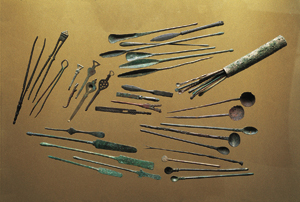Medicine in the Ancient World

Many Emergency Medical Service departments use the Star of Life – an image which is derived from ancient images of Asklepios. Snakes were believed to be sacred to the god, and he was often depicted as a bearded man with a walking staff that was entwined with serpents.
Life in the ancient world was risky business. The perils of war, disease, famine and childbirth are just a few examples of circumstances that contributed to a much lower average lifespan in the ancient world than we have in the modern era.
People in antiquity were no less concerned about the prevention and cure of maladies than they are now, however, and entire cults, sanctuaries and professions dedicated to health dotted the spiritual, physical and professional landscapes of the ancient world.
So what exactly did ancient cultures do to combat disease and injury, and did these methods have any real basis in science as we know it today? The answers may surprise you.
Prayer as Medicine

This first-century A.D. ceramic votive depicts an image of a uterus; It was probably dedicated by a woman in hopes of conceiving. Such a representation demonstrates a sophisticated understanding of both the anatomy and function of internal organs. Photo: British Museum.
In many societies, the gods played an integral role in human health. In the Greek world, the god Asklepios was dedicated exclusively to healing.a Sanctuaries called Asklepions drew the ill and injured, who would often travel for days to seek the healing that they believed these ancient sanitariums could provide. Similar in some ways to the modern spa, Asklepions provided baths, healthy foods and sanctuary rooms intended specifically for sleep and meditation.
Most Asklepions were located in remote and beautiful areas, such as the famous sanctuaries of Epidauros in Greece and Pergamon in northwest Turkey. Animal sacrifices and votive offerings were made at altars and temples to the god. Excavations at Asklepions have uncovered “anatomical votives,” so named because they represent the body part that was injured or affected by illness.
The Beginnings of Modern Medicine

This gilded bronze ear was presented to the Asklepion at ancient Pergamon by a woman named Fabia Secunda, who had it made “for the god Asklepios because the ear was healed in a dream.”
By the fifth century B.C., physicians and the god of healing had become intrinsically linked, with Asklepios as the divine patron of the medical profession. Hippocrates, the most famous physician of antiquity, lived during this time, and medical treatises that he authored would be used as medical textbooks for centuries to come.
From such writings, as well as other inscriptions, we see that ancient physicians knew that lancing, draining and cleaning infected wounds promoted healing, and that they knew of certain herbs that had healing and disinfecting properties.b Wild ginger was known to be helpful for nausea, and a particular clay found on the Greek island of Lemnos was believed to be helpful for ailments such as dysentery. This clay, called terra sigillata for the stamped discs that were formed from it and sold as medicine, contains the counterpart to elements such as kaolin and bentonite, which are used in modern medicines to treat diarrhea.
Surgical Techniques
Surgical techniques in the ancient world could be surprisingly advanced. The famous Roman physician Galen (c. 129–199 A.D.), who was born in ancient Pergamon near the Asklepion, is generally regarded as the most accomplished medical researcher of the Roman world, and some of his surgical procedures would not be seen again until modern times. He successfully conducted cataract surgeries by inserting a needle behind the lens of the eye in order to remove the cataract, and his described methods of preparing a clean operating theater reveal a keen awareness of contagion.1 While some of Galen’s practices and theories are still followed and praised by physicians today, others, such as his rejection of the stomach wall as having no role in digestion, have been proven by modern science to be erroneous.
Medicine as Science

This first-century A.D. relief of a leg was dedicated by a man named Tycheas as “a thank-offering to Asklepios and Hygeia” at the Asklepion on the island of Melos, Greece. Photo: Bridgeman Art Library.
By the seventh century A.D., medicine as a science that was relatively independent of religious restrictions had virtually disappeared in the west, as the use of cadavers for scientific dissection had been prohibited by the Church. However, Islamic scholars in the East were studying Greek medicine in depth.c Herbs such as henbane and Indian hemp (related to marijuana) were known for their anesthetic properties, and physicians stressed the effects of diet and environment on health.
Avicenna
Perhaps one of the most famous eastern physicians was Abu ‘Ali al-Husayn ibn ‘Abd Allah ibn Sina (980–1037 A.D.), whose work The Canon of Medicine codified existing medical knowledge. The Canon includes descriptions, causes and diagnostic techniques for conditions such as rabies, stomach ulcers, different types of hepatitis, breast cancer, facial paralysis, diphtheria, leprosy, diabetes, cancer and gout. Later translations Latinized his name to Avicenna, and by the 13th century his work had become the standard medical reference text throughout Western Europe.
Trepanation
Archaeology has further illuminated medical practices in the ancient world. Certain skeletons discovered during excavations demonstrate evidence of rather astonishing surgical successes. Perhaps the most startling evidence of sophisticated ancient surgery can be found in skulls that show signs of trepanation, a procedure still used today that is performed by drilling a hole into the skull to relieve intracranial pressure.
Trepanated skulls from ancient societies in Central and South America, Africa, Asia, Europe and the Near and Middle East have been found that perhaps date back as far as the Mesolithic period, about 12,000 years ago.2 By examining the bone regrowth around the surgical hole in the skull, scientists are able to determine how long the patient survived after undergoing the procedure. Some patients died immediately, some lived only a few weeks, but others seem to have healed completely.
The plague of Justinian was one of the worst epidemics in human history. Click here to read a Bible History Daily feature on the pestilence, including research on bacterial links between the Justinian plague and the Black Death.
Dentistry
Excavations have also revealed evidence of sophisticated dental practices in antiquity. In a mass grave at Horvat en Ziq in the northern Negev desert of Israel, a skull dating to about 200 B.C. was found that contains one of the earliest known dental fillings. A 2.5-millimeter bronze wire had been inserted into the tooth’s canal.d Elsewhere, skulls recovered from the catacombs in Rome, which were in use during the first through the fifth centuries A.D., exhibit some rather pricey dental work: Several were recovered that have gold fillings.

A 2.5 millimeter bronze wire (indicated by an arrow) in this tooth’s canal is evidence of early dentistry. Discovered in a mass grave at Horvat En Ziq, a small Nabatean fortress in the northern Negev desert in Israel, the incisor contains one of the earliest known fillings, dating to about 200 B.C.E. Photo: Israel Antiquities Authority.
Medical Instruments
Ironically, it is often the funerary monuments and graves of ancient doctors that attest to their care of the living. Tablets that decorated funerary altars of physicians often depicted the instruments of their profession—objects that look remarkably similar to instruments used by surgeons today. Scalpels, forceps, forked probes for examining wounds, needles for stitching wounds, small spoons for cleaning wounds and measuring medicines, catheters and even gynecological specula are all examples of instruments employed by the medical doctors of antiquity.

This array of bronze surgical instruments, from a private collection in Jerusalem, dates from 40 B.C.E. to 400 C.E. and includes spoons used to scrape out wounds (lower right), a forked probe (among the spoons), knife and scalpel handles (center, their iron blades have disintegrated), spatula probes for working in wounds (lower left), forceps (upper left), hooks used to hold the skin back (left of center), and cyathisconele, cupped tools used to clean wounds (top center). Photo: Zev Radovan.
Of course, calling on a higher power for assistance during a physical trial or illness was as common in the ancient world as it is today. Many modern hospitals have nondenominational worship spaces where people can pray and meditate; people in antiquity visited shrines and temples to do the same. Individuals preparing to undergo dangerous ordeals such as childbirth or battle would often invoke the protection of the divine. Even as medical science continues to evolve, the contemplation of mortality will likely continue to cause humans to look beyond the known for the explanations that even modern science cannot yet provide.
 Sarah Yeomans was Director of Educational Programs at the Biblical Archaeology Society. She is an archaeologist specializing in the Imperial period of the Roman Empire with a particular emphasis on religions and ancient science. Yeomans holds an M.A. in archaeology from the University of Sheffield, England, and an M.A. in art history from USC. She has conducted archaeological fieldwork in Israel, Italy, Turkey, France and England and has worked on several television and film productions, most recently as an interviewed expert on Fox’s The Nativity: Facts, Fiction and Faith. Her current research involves ancient Roman medical technology and cult, as well as the impact of epidemics on Roman society. She is generally happiest when covered in dirt, roaming archaeological sites somewhere in the Mediterranean region.
Sarah Yeomans was Director of Educational Programs at the Biblical Archaeology Society. She is an archaeologist specializing in the Imperial period of the Roman Empire with a particular emphasis on religions and ancient science. Yeomans holds an M.A. in archaeology from the University of Sheffield, England, and an M.A. in art history from USC. She has conducted archaeological fieldwork in Israel, Italy, Turkey, France and England and has worked on several television and film productions, most recently as an interviewed expert on Fox’s The Nativity: Facts, Fiction and Faith. Her current research involves ancient Roman medical technology and cult, as well as the impact of epidemics on Roman society. She is generally happiest when covered in dirt, roaming archaeological sites somewhere in the Mediterranean region.
This article was originally published in November 2013.
Notes
a. Bronwen Wickkiser, “Asklepios Appears in a Dream,” Archaeology Odyssey, July/August 2005.
b. George B. Griffenhagen, “Origins: On the Pill,” Archaeology Odyssey, May/June 2002.
c. David W. Tschanz, “Origins: A Cure for the Common Cold?” Archaeology Odyssey, Summer 1998.
d. Hector Avolos, “Ancient Medicine,” Bible Review, June 1995.
1. See Galen, Galen on the Usefulness of the Parts of the Body, trans. by Margaret Tallmadge May (Ithaca, NY: Cornell University Press, 1968) and A. Sorsby, A. Modern Ophthalmology (London: Butterworths, 1963).
2. See S. Missios, “Hippocrates, Galen, and the Uses of Trepanation in the Ancient Classical World,” Neurosurgical Focus 23(1):E11 (2007); P. Marino and M. Gonzales-Portillo,” Preconquest Peruvian Neurosurgeons: A Study of Inca and Pre-Columbian Trephination and the Art of Medicine in Ancient Peru” Neurology 47:4, (2000), pp. 940–955.









